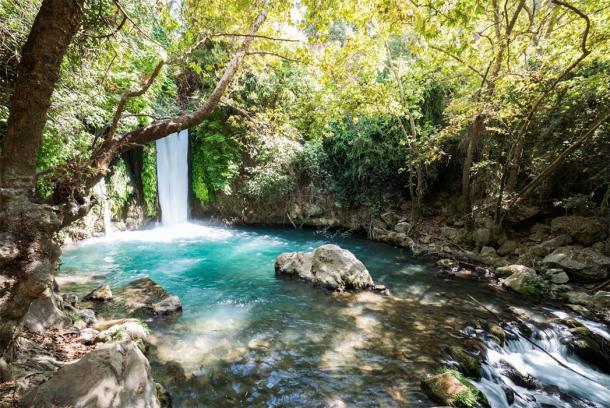Archaeologists believe that they have uncovered a long-lost Church in the Golan Heights. They found it in the ancient city of Banias, that was known as Caesarea Philippi in the time of Jesus Christ. It is believed to be the site of one of the most famous Jesus miracles in the Bible, that of the bleeding woman. This site thus marks the place where one of the key events in early Christianity took place.
The early Christian place of worship was found in the part of the Golan administered by Israel, but in which the international community does not recognize their rule in the area. Israeli experts were excavating the ancient city of Banias when they found the early Church. It dates from the 4 th century AD and was built on an ancient temple that was dedicated to Pan, the Greek God of shepherds, sex, and nature. An altar dedicated to Pan with an inscription was also unearthed. The site had been repurposed by the Christians and they had turned the temple into a church.

The excavation site at Banias, known as Caesarea Philippi, which experts now believe could be the site of a Jesus Miracle (Banias Excavations Team)
Discovery of Early Christian Church at Banias
The ruined Christian place of worship was found beneath an ancient pathway. It was found adjacent to the mouth of a cave which once contained a spring. The leader of the dig, University of Haifa Prof. Adi Erlich, told Aleteia that “the location of the excavation is unique in that it combines a cliff, a cave, springs and a terrace created in ancient times from the collapse of part of the cliff on which the temple was built.”
At some point, the Christians took over the site and it became a center of Christianity by the 4 th century BC, and it even had its own bishop by 320 AD. Prof. Erlich told Aleteia that “the original Roman temple architecture structure was Christianized and turned into a church.” A number of Christian finds were made including a 5 th century AD stone cross that had graffiti, possibly etched by pilgrims.

University of Haifa Prof. Adi Erlich led the dig and can be seen here with a Roman altar dedicated to Pan. This artifact suggests that the site was used for religious purposes before the Christians arrived. (Banias Excavations Team)
Could This Be the Location of a Jesus Miracle?
Erlich told the Times of Israel that it was possible that “the church was built to commemorate Jesus’s significant interactions with Peter.” According to the Gospel of Matthew in the New Testament , St. Peter recognized Jesus as the Messiah here. In response to this Jesus told his disciple: “You are Peter, and upon this rock, I will build my church,” according to Aleteia. This moment, known as the confession of Peter, is regarded as pivotal in the development of the early Christian church.
However, Banias or Caesarea Philippi is also important to Christians because it is the location of one of Jesus’ best-known miracles, that of the healing of the bleeding woman. According to the Gospels, the woman had been bleeding for twelve years and no-one could help her. Because of her bleeding, she would have been regarded as polluted and impure, and would have consequently been ostracized. In desperation, she touched the cloak of Jesus as he passed her hoping for a Jesus miracle. Miraculously she was cured, and her bleeding stopped.
Statue to Commemorate Jesus Miracle Broken to Provide Holy Relics
The miracle of Jesus healing the bleeding woman is recounted in the Gospels of Matthew, Mark and Luke. The Daily Mail reports that Eusebius, an important Church historian, “wrote that once the bleeding woman was healed she erected a statue to commemorate the miracle in a church by the springs in Caesarea Philippi.” According to several sources, the statue was later broken into many pieces by Christians who prized them as holy relics.
Prof. Erlich is quoted by the Daily Mail as saying that “we suggest that the church revealed by us might have been this church that was related to the miracle.” He believes that the small church found on top of the ancient temple is the best candidate for the site of the miracle of the bleeding woman because it was likely a memorial chapel. Nevertheless, another larger church was found nearby some 30 years ago.

The Nature and Parks Authority, who runs the Banias Nature Reserve, hopes that the discovery will attract more tourists to the area, which is also known for its gorgeous waterfall. ( LevT / Adobe Stock)
Why Was the Lost City of Banias Abandoned?
The discovery is helping researchers to better understand the history of Banias, which was possibly named after Pan. No one is really sure why it was abandoned. The Daily Mail quotes Erlich as saying that “the first phase of the church was hit by an earthquake, with half of the building sinking about a meter.” Despite this, it continued in use for many centuries, but was abandoned in the Early Middle Ages. This was possibly related to the Arab expulsion of the Byzantines from the area after the Battle of Yarmouk (636 AD), the subsequent decline in Christianity and the growth of Islam.
Excavations at the ancient city have been completed. Aleteia quotes Dr. Iosi Bordowicz, of the Israel Nature and Parks Authority, as saying that “the finds will be conserved and made accessible for future pilgrims.” It is also hoped that the church, which is located near a famous waterfall and many other archaeological sites, will become a tourist destination.
Top image: Depiction of the Jesus miracle story of the healing of a bleeding woman, contained in the Ottheinrich Bible. Source: Public domain
By Ed Whelan
 RSS Feed
RSS Feed















 November 13th, 2020
November 13th, 2020  Awake Goy
Awake Goy  Posted in
Posted in  Tags:
Tags: 













